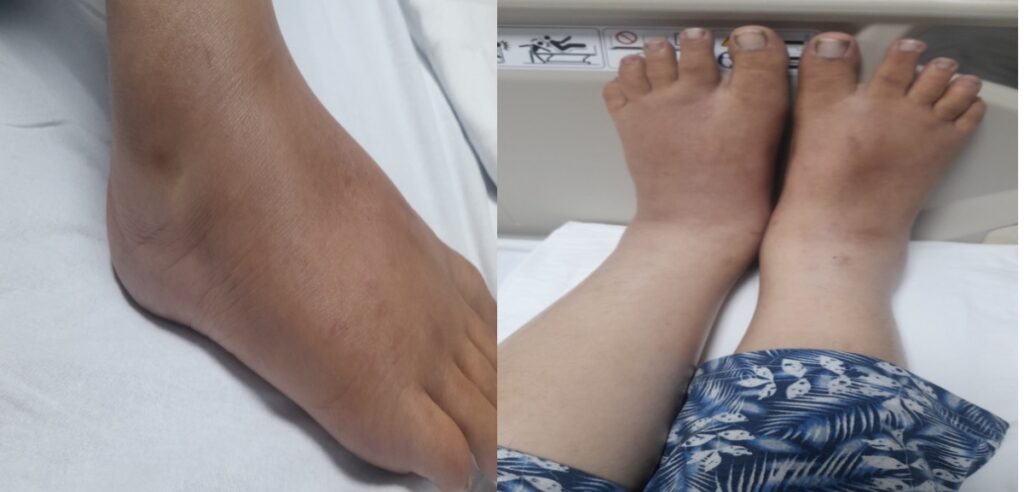Dr.Shobika,Dr.C Jayakumar,Dr.Praveena
AIMS KOCHI
Sixteen year old girl with normal past medical reccords presented with one month history of joint pain of the hands.
She had progressive pedal edema followed frothy urine
On evaluation she was found to have anemia,thrombocytopenia, altered renal function and alopecia.
Her immunisation is partial only till 6 months of age.
Auxololgy showed normal growth parameters.
On clinical examination-pulse -86b/min,all peripheral pulses are felt,
Pallor +,b/l pitting edema +
Skin – erythematous- discoid lupus lesions over scalp,alopecia
Palatal erythma+
Systemic examination were within normal limits.

Investigations :
Labs TC-5.97ku/ml,N-66.7%,L-25.6%,
Hb-7.3g/dl,
Platelets -174ku/ml)
high ESR 85/hr
DCT-2+ with normal CRP(0.57)
RFT- normal urea with creatinine (1.43)
C3 of 26 and c4 of 3.7-both low
Urine routine showing proteinuria,hematuria and pyuria
USG abdomen showed normal sized mildly echogenic kidneys and gall bladder polyp.
ECHO showed non tapering left main coronaryartery suggestive of coronary vasculitis
ANA result -positive(IF)
Grade 3, pattern-homogenous
ANA blot ribosomal P strong positive
Nucleosome and histone mild positive
Anti ds DNA-182
SLE disease activity index
(SLE DAI)36(severe flare)
Ophthal consult -no evidence of vasculitis
With a clinical presentation suggesting of SLE with lupus nephritis was made as diagnosis.
The child was started with inj.methylpred (30mg/kg )at 750mg iv for 3 days and T.HCQ 300mg.
By day 2 of iv methylphednisolone ,the child showed clinical improvement with reducing edema.
Plan for renal biopsy was done.
She was started on Diuretics i/v/o pedal edema.
After that cyclophosphamide
Dosing(500 to750mg/m2 max 1gm)500mg was started and she showed symptomatic improvement with reduced pedal edema and improved renal function and reduction in creatinine level(1.1) following which methylprednisolone was tapered to iv 50mg od.
Further steroid dose was switched to oral wysolone (1mg/kg),her anti phospho lipid syndrome (APS )work up came positive (Lupus anti coagulant and anti beta 2 glycoprotein) started on aspirin.
Nephro consult for hyperkalemia suggested to give K bind sachet for 3 days and to monitor potassium.
She was kept on regular follow up.
Dicussion:
Systemic lupus erythematous:
Is a chronic inflammatory disease of unknown cause that can affect the skin,joints,kidneys,lungs,nervous system and other organs of the body.
Predominance in female adolecents than in males.
Clinical manifestations:
Persistent fever,fatigue,anorexia,weight loss,arthralgia,malar rash,discord rash,alopecia,photosentivity
Lab findings:
Anaemia, Persistent thrombocytopenia
Hemolytic anemia
Hematuria
Proteinuria
Hypocomplementemia
Autoantibodies(ANA,anti ds DNA,anti Smith, anti RNP,lupus anticoagulant)
Elevated liver enzymes
Increased ESR but normal CRP
Diagnosis:
Systemic lupus erythematous collaborating clinics (SLICC )criteria(4 of 17 criteria)
European league against rheumatism (EULAR )criteria(4 of 11 criteria)
Treatment:
Mild SLE- NSAIDs and hydroxychloroquine (<_5mg/kg per day upto 200mg in most children with an adult maximum of 400 mg per day.
Prednisolone(less than 0.35mg/kg per day)
Moderate SLE- hydrochloroquine,prednisolone,mycophenolate mofetil,azathioprine.
Severe SLE- IV Cyclophosphamide,Rituximab,azathioprine
Treat children who have evidence of severe renal, CNS, or hematologic disease with corticosteroids.
The dose varies with the intensity of SLE on the organ system involved and in select individuals with serologic disease activity. Consider initiating therapy with daily prednisone (1 mg/kg/d) or higher-dose alternate-day prednisone (5 mg/kg/d, not to exceed 150-250 mg, depending on the size of the patient). Alternatively, lower-dose daily prednisone (0.5 mg/kg) may be used in combination with intermittent high-dose IV methylprednisolone (30 mg/kg/dose, not to exceed 1 g) on a weekly basis.
Prognosis
The 5-year survival rate for children with SLE is more than 90%. Most deaths in children with SLE are the result of infection, nephritis, renal failure, neurologic disease, or pulmonary haemorrhage
